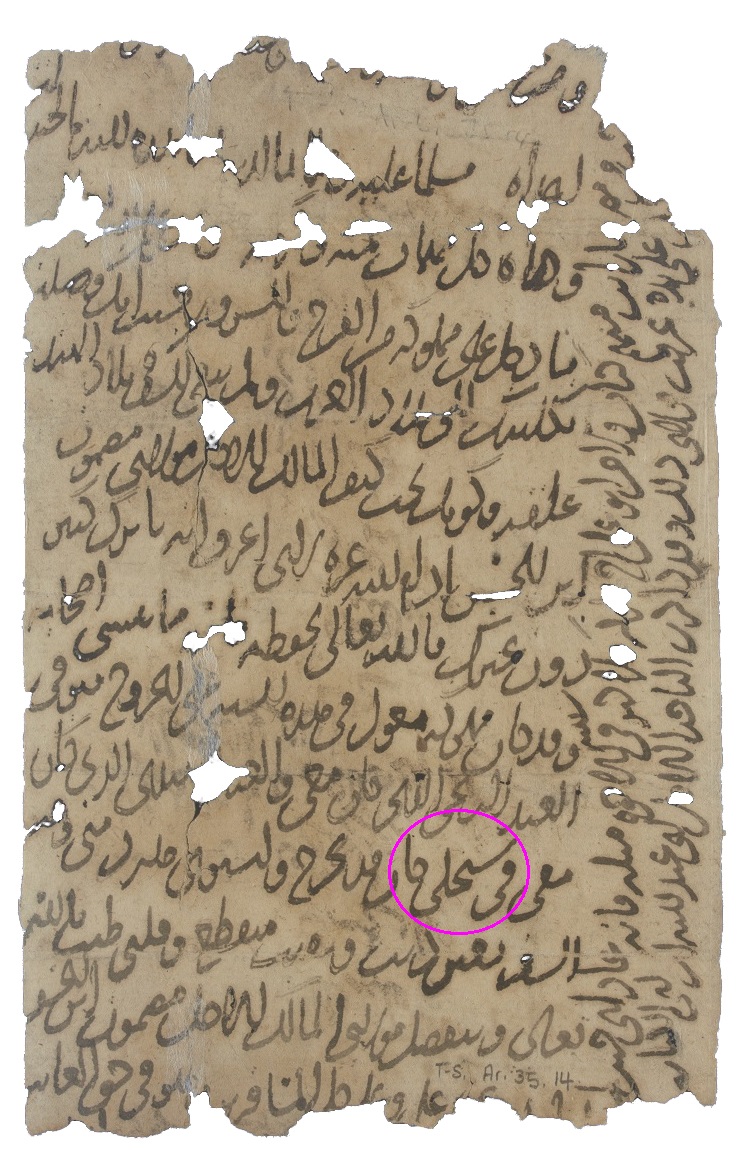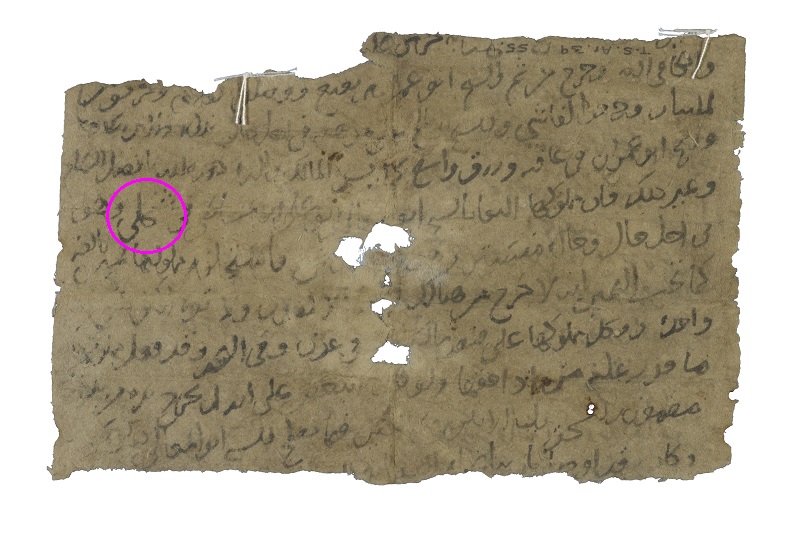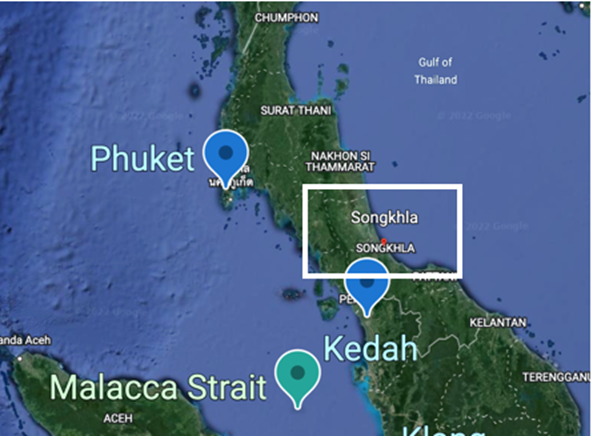A Tale of Two Cities: From Singora to Shingly
Amir Ashur, Elizabeth Lambourn, and Alan Elbaum
It is always a thrilling day when you discover a new place name in Cairo Genizah documents. You break out maps and Genizah publications, search for the term on Google and online databases, and try to come up with an identification that is geographically, historically, and linguistically plausible. Sometimes it’s doubly thrilling: you might discover that your first identification, which you’ve announced with great fanfare at an international conference and on social media, is 2500 kilometers off the mark. So let us take you on our journey of the misidentification and identification of سىحلى.
First, a word on the background of the India Book, S. D. Goitein’s collective name both for the hundreds of Genizah documents about the medieval Indian Ocean trade and for his projected book based on those documents. Four out of the seven volumes have been published by Goitein and M. A. Friedman. Over the last year, we have begun working toward publishing the remaining three volumes, with support from the Princeton Geniza Project, headed by Marina Rustow, and from the Ben-Zvi Institute, headed by Miriam Frenkel. Along the way we’ve added dozens of new documents to the original corpus of 384, including about a dozen which had escaped notice due to being written in Arabic script.
In one of these Arabic letters, T-S Ar.35.14, Alan first noticed the place name سىحلى, written without diacritics, as is common in Arabic documents:

T-S Ar.35.14, recto
This document is a letter from the time of the Nagid Maḍmūn b. Yefet of Aden, who died in 1151 CE. The sender conveys his happiness that the addressee is transferring his business to the West (bilād al-gharb) and cutting his ties with India (bilād al-hind). He himself intended to set out this year but has been prevented due to lack of support—he describes himself as “cut off” (munqaṭiʿ) on account of the death of his East African slave (al-ʿabd al-zanjī), and something to do with “the Indian slave (al-ʿabd al-hindī) who was with me in سىحلى.” 1 There does not seem to be any further information about the sender’s time in سىحلى or even about his current location. Most likely either the sender or the addressee is Muslim, because the letter ends with a conventional prayer for Muḥammad (وصلى الله على محمد النبي عليه السلام).2 Based on the references to East Africa, Yemen, and India, we can place this sender’s context in the greater Indian Ocean world. But there are no fewer than sixty possible combinations of diacritical points for سىحلى, so we remained unable to identify it.3
Enter T-S Ar.39.55, another of the Arabic-script letters from the India trade found by Alan, likely dating to the second half of the twelfth century.4 Here, both sender and addressee can be identified as Jewish, because one phrase appears in Hebrew characters in the middle of the Arabic. The sender mentions locations including Aden, Malabar, and Fanṣūr (present-day Barus in western Sumatra, the most common Southeast Asian locale mentioned in Genizah documents). In addition, he provides updates on the health and business of other traders: “I met with Abū l-Maʿālī the son of Abū ʿAlī Ibn al-Amshāṭī in شنخلى, and he is in the utmost health and prospering. . . and I made him take a strong oath. . . that he would not leave from there [before] . . . .” 5

T-S Ar.39.55, verso
While T-S Ar.35.14 shows that an Arabic-speaking Jewish or Muslim merchant spent an unknown length of time in سىحلى, T-S Ar.39.55 shows that a Jewish merchant (from the well-known Ibn al-Amshāṭī family) lived there for an extended period.
Even better, we now have some diacritics. The word appears to be written شنخلى, so we have gone from sixty combinations to only two: ŠNḴLY or ŠNḴLĀ. Another round of searching led to a footnote in a 1909 monograph on Ptolemy’s Geography mentioning that “Suṅkhala” is an old form for “Singora,” an important medieval city on the site of present-day Songkhla on the eastern coast of the Malay peninsula (Gerini, 1909, p. 519). Despite the obscurity of the citation and the lack of corroborating sources, this seemed like a promising option, not only linguistically but also historically and geographically. Archaeologists and historians of Southeast Asia have long known that Satingpra (the old capital near Singora/Songkhla) was a major trading crossroads between the Indian Ocean and China in the period of these Genizah letters (Stargardt, 2001). As Genizah scholars, we were delighted to find medieval documentary evidence that Jewish traders traversed this route.

Google Maps, 2023, maps.google.com with authors' edits
The finding that Jewish traders reached Southeast Asia would not have been new; the exciting piece would have been the discovery of the role of Singora. On the significance of Southeast Asia in general (bilād al-jāwa) for the 12th-century Genizah traders, see Marina Rustow’s November 2021 Fragment of the Month, including an inquiry into the location of the mysterious “Kalah.” Goitein had suggested identifying Kalah with Kedah; if indeed سىحلى were Singora/Songkhla, this would suggest that the Kedah-Singora land route could have been used by traders who wished to avoid sailing down the Malacca Strait.
In retrospect, we ought to have noticed at least one serious flaw with this identification: the word in T-S Ar.39.55 is written with a shīn rather than the expected sīn. Under the influence of confirmation bias, we hypothesized that this scribe might have an idiosyncratic way of dotting his letters (dots for sīn and no dots for shin), given the term الفاشي in the line above, which we took to be part of the name of a trader (al-Fāsī). However, on closer study, there is no scribal idiosyncrasy, and in fact the term in the line above is probably another, still-unidentified place name (FĀŠY?).6 (Additionally, though we couldn’t have known this at the time, the apparent dot over the ـحـ is likely only a smudge, as ـجـ is the correct reading.)
Although the identification was not certain, it was convincing enough for Alan to post it on the Princeton Geniza Lab Twitter page in June 2022 and for Amir to present our joint paper on it at the Indian Ocean World Archaeology Conference at Exeter in December 2022.
A couple months later, Amir was working on the edition of ENA 2560.5 (India Book, VI, 3) when he noticed an unfamiliar place name written in Hebrew characters as שנגלי (ŠNGLY). Alan immediately made the connection with سىحلى. This is a fine example of how Judaeo-Arabic texts can assist us in reading Arabic texts with no diacritics: in this case it proves that the correct way of dotting سىحلى is شنجلي. With this new information, we agreed that we could read the place name correctly, but we still did not question our initial identification of that location as Singora on the Gulf of Thailand. The writer of ENA 2560.5 expresses his anguish about his loneliness in a foreign country and laments the death of Maḍmūn I of Aden, so we can date it to 1151 or a little bit later. He apologizes for not writing a more elaborate letter due to the lack of paper in שנגלי (ŠNGLY). From the India Book documents we know that paper was scarce in India and had to be imported. Based on this reference, it seemed that paper was also scarce on the Malay peninsula.
Fast forward to June 2023 and the canteen at Cambridge University Library where Amir was busy updating Elizabeth (Lambourn) on the new documents and information coming to light. As he moved on to Alan’s reading of T-S Ar.39.55 and another occurrence of the mysterious سىحلى , Elizabeth had a brainwave, one of those spontaneous moments of insight that scholars live for. Seeing the diactritical marks clearly identifying the first letter as a shīn rather than a sīn it was obvious that the toponym was Shingly! Shingly is famous in Jewish Indian history as a major premodern settlement on the Malabar coast, in some accounts a principality possessed of its own sovereign, and the history of the name has been well studied by Ophira Gamliel. While there are ample early modern occurrences of the toponym in European sources – under the forms Shingly, Shingola, Cingilin, Cingalah, even, Zinglantz - and occurrences in Hebrew poetry, to date it is medieval Arabic geographies that have provided the earliest evidence for the existence of this toponym, as well as its Jewish population. As Gamliel notes, “it is in Arabic sources that the place name Shingly originates” given as sinjlī (سنجلي ) or šinklī (شنكلي).” Abū l-Fidāʾ (1273–1331) mentions Shaliyat and Shingly as two places in Malabar inhabited by Jews while the Mamluk Syrian geographer al-Dimashqī (1256–1327) reported Shingly and Fandarina (Pantalayini-Kollam) as having Jewish populations (Gamliel, 2018, p. 64).The two newly identified uses of this toponym — variously شنجلى and שנגלי — predate these two Arabic geographies by some eighty years. The only roughly contemporary mention of Shingly, and then in a slightly garbled form, would appear to be in the 12th century Armenian Description of Cities, Indian and Persian, a short merchant guide covering Afghanistan to China. The anonymous Armenian author mentions the city of Shikl located south of Fandarina and which was reported to have a large Christian population (Elizabeth is grateful to Peter Cowe for indicating this reference and sharing his revised translation of the Armenian text back in 2013).
Not only are these occurrences remarkably early, they also place Shingly firmly within the Jewish trade networks of the period while at least hinting at the existence of a settled Jewish population there. Given that the Genizah documents allow us to map Jewish merchant activities all along India’s western seaboard from Kutch, in what is now modern Gujarat State, as far as Kollam in southern Kerala and to Sri Lanka beyond, the addition of another port may not at first appear that significant. However, Shingly enjoyed a particularly significant place within Keralan geography and politics.
Much ink has been spilt attempting to identify the exact location of Shingly. The most convincing is Gamliel’s suggestion in her forthcoming book Judaism in South India ca. 900s–1950s: Relocating Malabar Jewry (Michigan: Arc Humanities Press) that “the placename Shingly might represent an earlier pronunciation of Chendamangalam” as follows: śīṅgalī> śennǝṅgale> śennǝṅgalam > śennaṅgalam > cennamaṅgalam. Chendamangalam7 is now a small village some ten kilometers inland from the coast of central Kerala; its nearest large modern city is Kochi (formerly Cochin). But the area has always been extremely important both for its central location on the Keralan coastal plain and for its access to the famous Kerala backwaters which provided almost year-round water transport along the length of the region, safe from the winds and waves of the Indian Ocean itself. Muziris, one of the famed ports of Indo-Roman trade in the early first millennium was most probably located in this area and has been identified with the site of Pattanam; from the later medieval period to today, Cochin (now Kochi) has been the major port of international trade. In the intervening period, the area was central to the Cēra dynasty (r. ca. 800–1120 CE) with its capital city Makotai, or Mahodayapuram located near Kodungallur, just to the north of modern Kochi. The siltation of the Kerala coastline and the subsequent alteration of river courses means that port sites have shifted regularly over the centuries and become gradually distanced from the coastline (Shajan et al., 2004). Chendamangalam then was located close to the former seat of Cēra power and much closer to the coast, making it a natural port for West Asian merchants to target. Even though, by the period of our sources, the Cēra dynasty had disintegrated into a patchwork of independent polities, the documents identified and read by Alan Elbaum and Amir Ashur suggest that by the 1150s Jewish merchants were now engaged with the Cēra’s successors in this area, the rulers and administrators of the region of Kōlattunātu (Narayanan, 2013, p. 131). Why Shingly is not mentioned in earlier Genizah documents and is absent from al-Idrīsī’s Kitāb Nuzhat al‐Mushtāq which was begun in Sicily in 548/1154—a geography otherwise very up to date about active Malabari ports and their commodities—is a question that will require further research. Whatever the answer, the Genizah documents once again demonstrate their significance for South Asian history and their capacity to illuminate some of the most important transitional moments in the sub-continent. If we agree that the correct reading of this toponym is Shingly rather than Singora, the disappointment of not being able to add a port in the Gulf of Thailand to the map of Jewish trade networks is amply compensated by the exciting possibilities of this corrected reading.
We wish to thank Dr. Ophira Gamliel for her comments and for sharing with us her forthcoming publication.
Footnotes
1 We haven’t yet come up with a satisfactory reading for what happened with the Indian slave. It might read as follows (with thanks to Yusuf Umrethwala for suggestions): قد تخرج واشترى جاريته(؟) مني وقت السفر بغير دين.
2 It is also possible that both were Muslim. Note that Jews did use such Islamic formulae in state documents, like petitions, where they were integral parts of the document.
3 Two options for س, five options for ـىـ, three options for ـحـ, and two options for ى.
4 The dating is based on the mention of Ibn Daghīsh, who appears in T-S Misc.28.187 ca. 1180 CE.
5 The content of the oath is too faded for us to read. It may be until Abū l-Maʿālī completes a certain task, or something like “until I return.”
6 وخرجوا من [ثم] لمليبار ورجعوا لفاشي . . .
7 A Hebrew tombstone dated 1236 and found in Chendamangalam supports this suggestion. See https://en.wikipedia.org/wiki/Chendamangalam_Synagogue
Bibliography
M. A. Friedman, Ḥalfon and Judah ha-Levi—the Lives of a Merchant Scholar and a Poet Laureate according to the Cairo Geniza Documents (Hebrew), Jerusalem (Ben-Zvi Institute & The David Moses and Amalia Rosen Foundation) 2013 (India Book IV/A).
Gamliel, O. (2018). ‘Back from Shingly: Revisiting the premodern history of Jews in Kerala’, The Indian Economic and Social History Review, 55(1): 53–76.
Gerini, G.E. (1909). Researches on Ptolemy’s Geography of Eastern Asia (further India and Indo-Malay Archipelago). Royal Asiatic Society & Royal Geographical Society.
S. D. Goitein & M. A. Friedman, India Traders of the Middle Ages: Documents from the Cairo Geniza (‘India Book’), Leiden and Boston (Brill and Ben Zvi Institute) 2008 [2007].
–, Joseph Lebdī—Prominent India Trader, Cairo Geniza Documents (Hebrew), Jerusalem (Ben-Zvi Institute & The David Moses and Amalia Rosen Foundation) 2009 (India Book I).
–, Abraham ben Yiju—IndiaTrader and Manufacturer, Cairo Geniza Documents (Hebrew), Jerusalem (Ben-Zvi Institute & The David Moses and Amalia Rosen Foundation) 2010 (India Book III).
S. D. Goitein & M. A. Friedman with the assistance of Amir Ashur, Ḥalfon The Traveling Merchant Scholar—Cairo Geniza Documents (Hebrew), Jerusalem (Ben-Zvi Institute & The David Moses and Amalia Rosen Foundation) 2013 (India Book IV/B).
Narayanan, M.G.S. (2013). Perumāls of Kerala: Brahmin oligarchy and ritual monarchy: Political and social conditions of Kerala under the Cēra Perumāls of Makōtai (c. AD 800–AD 1124). 2nd rev. ed. Thrissur, K.L. CosmoBooks.
Shajan, K.P., Tomber, R., Selvakumar, V., & Cherian, P.J. (2004). Locating the ancient port of Muziris: Fresh findings from Pattanam. Journal of Roman Archaeology, 17.
Stargardt, J. (2001). ‘Behind the shadows: Archaeological data on two-way sea-trade between Quanzhou and Satingpra, South Thailand, 10th–14th century’, in A. Schottenhammer (Ed.), The Emporium of the World: Maritime Quanzhou, 1000–1400 (pp. 309–93).
Cite this article
Ashur, Amir, Elizabeth Lambourn, and Alan Elbaum. 2023. "A Tale of Two Cities: From Singora to Shingly." Taylor-Schechter Genizah Research Unit. doi:10.17863/CAM.107303.
If you enjoyed this Fragment of the Month, you can find others here.
Contact us: genizah@lib.cam.ac.uk
The manuscripts in this article are part of the Cairo Genizah Collection in Cambridge University Library. To see more items from this collection visit: https://cudl.lib.cam.ac.uk/
